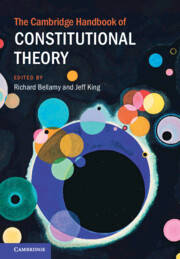Book contents
- The Cambridge Handbook of Constitutional Theory
- The Cambridge Handbook of Constitutional Theory
- Copyright page
- Contents
- Figures
- Contributors
- Frontispiece
- Preface and Acknowledgements
- 1 Introduction
- Part I Values
- Part II Modalities
- 10 Impartiality
- 11 Constitutional Legitimacy
- 12 Sovereignty
- 13 Constituent Power
- 14 Representation
- 15 Deliberation
- 16 Opposition
- 17 The Separation of Powers
- 18 The Rule of Law
- 19 Constitutional Conventions
- 20 Secularism
- 21 Constitutional Review
- 22 Constitutional Interpretation
- 23 Proportionality
- 24 Civil Disobedience
- 25 Constitutional Entrenchment
- 26 Emergency Powers
- 27 Regulation
- 28 Cost–Benefit Analysis
- 29 Revolution
- Part III Institutions
- Part IV Challenges for Constitutional Democracy
- Bibliography
- Index
- References
28 - Cost–Benefit Analysis
from Part II - Modalities
Published online by Cambridge University Press: 27 March 2025
- The Cambridge Handbook of Constitutional Theory
- The Cambridge Handbook of Constitutional Theory
- Copyright page
- Contents
- Figures
- Contributors
- Frontispiece
- Preface and Acknowledgements
- 1 Introduction
- Part I Values
- Part II Modalities
- 10 Impartiality
- 11 Constitutional Legitimacy
- 12 Sovereignty
- 13 Constituent Power
- 14 Representation
- 15 Deliberation
- 16 Opposition
- 17 The Separation of Powers
- 18 The Rule of Law
- 19 Constitutional Conventions
- 20 Secularism
- 21 Constitutional Review
- 22 Constitutional Interpretation
- 23 Proportionality
- 24 Civil Disobedience
- 25 Constitutional Entrenchment
- 26 Emergency Powers
- 27 Regulation
- 28 Cost–Benefit Analysis
- 29 Revolution
- Part III Institutions
- Part IV Challenges for Constitutional Democracy
- Bibliography
- Index
- References
Summary
“Cost-benefit analysis” (CBA) denotes the class of qualitative or quantitative methodologies that evaluate governmental policy choices in light of overall well-being. CBA plays a major role in non-constitutional U.S. public law. Executive agencies are required by Presidential order to employ CBA; courts construe ambiguous statutory language as permitting or requiring CBA; and courts also frequently find that administrative agencies’ mistakes in applying CBA are “arbitrary and capricious” under the Administrative Procedure Act. By contrast, CBA plays virtually no role in US constitutional law. It is generally absent not only from constitutional rights doctrine, but also from separation-of-powers and federalism doctrines. If overall well-being indeed plays a significant ethical role in determining the ethical status of governmental choices – which is what would justify the centrality of CBA to non-constitutional U.S. public law – its absence from constitutional law is quite puzzling. This can’t be justified by the premise that constitutional rights “trump” overall well-being (since CBA is absent even from those various parts of constitutional law where no such trumps are in play); nor the Constitution’s text (since the actual practice of the Supreme Court is only loosely textualist); nor original meaning (since the Court’s doctrines, on many questions, are not originalist); nor democratic legitimacy (since the Court could accommodate democratic legitimacy via a deferential version of CBA).
Keywords
- Type
- Chapter
- Information
- The Cambridge Handbook of Constitutional Theory , pp. 470 - 490Publisher: Cambridge University PressPrint publication year: 2025

